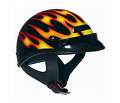Finding the Right Harley HelmetAside from selecting the right helmet style, proper fit is extremely important when selecting a Harley helmet or any other motorcycle helmet. A helmet that doesn’t fit right impacts your riding experience either by feeling uncomfortable or moving around while you are trying to ride.
Helmet FitBuying a helmet based on your hat size or guessing the size (small, medium or large) could result in a helmet that fits poorly. Helmet manufacturers sometimes have different sizing so proper measurement is key to getting the right size. Refer to the Helmet Measurement page for instructions on how to properly measure you head and choose the right size helmet. If buying your helmet online, each brand usually provides a sizing chart.Helmet CareAlways follow the manufacturer’s directions on caring for your helmet. A helmet should always be handled with care. Dropping or impacting a helmet may reduce it's ability to protect you in case of an accident. Here are some tips on maintaining your helmet:
Replacing Your HelmetDepending on the helmet manufacturer, it is recommended to replacing your helmet every 2-4 years. If your helmet is damaged or showing extreme wear it should be replaced. Replacing your helmet every few years is a good idea as its protection may deteriorate with time and wear. As newer materials and helmet designs become available, helmets become stronger, lighter, and more comfortable. All helmets must have the month and date of production stamped on inside according to DOT and federal regualtions.Helmet StylesHelmets come in many different styles based on the type of riding and preference of coverage.Half Helmets - Typical of most Harley Davidson helmets are the half style helmets. Sometime called beanie, or shortie helmets, half helmets are a popular choice for those who ride cruisers or want that open feeling while still wearing an approved helmet. Open Face Helmets - An open face or 3/4 helmet is similar to a half helmet except for havng side or ear coverage. This is another popular helmet with cruisers and some models can accomodate headphones used to communicate with a passenger. Half helmets with material or leather neck curtains are still ocnsidered half helmets despite the side coverage they provide. Full Face Helmets - More typically worn by street bike riders and racers, full face helmets provide the greatest protection and are worn by many Harley riders. A full helmet also provides more protection from wind, bad weather, and debris such as bugs and rocks. Hybrid Helmets - Helmets that convert from full face to open face helmets are considered hybrids. These helmets have an integrated chin and shield than when lifted become an open face style helmet. Check out some reviews of Harley helmets. Johns Cycle Parts stocks a variety of helmets that we recommend. Helmet DesignationsDOTDOT is the Federal Government’s Department of Transportation (DOT). DOT sets minimum standards that all helmets sold for motorcycling on public streets must meet. The standard is Federal Motor Vehicle Safety Standard 218 (FMVSS 218) and is known commonly as the DOT standard.SNELLThe Snell Memorial Foundation is a private not-for-profit organization that sets voluntary standards for motorcycle helmets, bicycle helmets and auto racing helmets, as well as other kinds of protective headgear. Snell standards are the world’s toughest and demand quite a bit more protective capability in helmets than anybody else on the planet. However, in most states within the U.S. DOT is the standard by which helmet laws are set. Both organizations have rigid procedures for testing:
Novelty or Non-DOT helmetsNovelty Helmets are neither DOT nor Snell approved. While I believe in a biker's right to choose (wearing a helmet), placing a DOT sticker on a novelty helmet fools very few cops. While a novelty helmet may be more comfortable it in no way provides any protection to your head. |
Harley Helmet – Selection Guide



